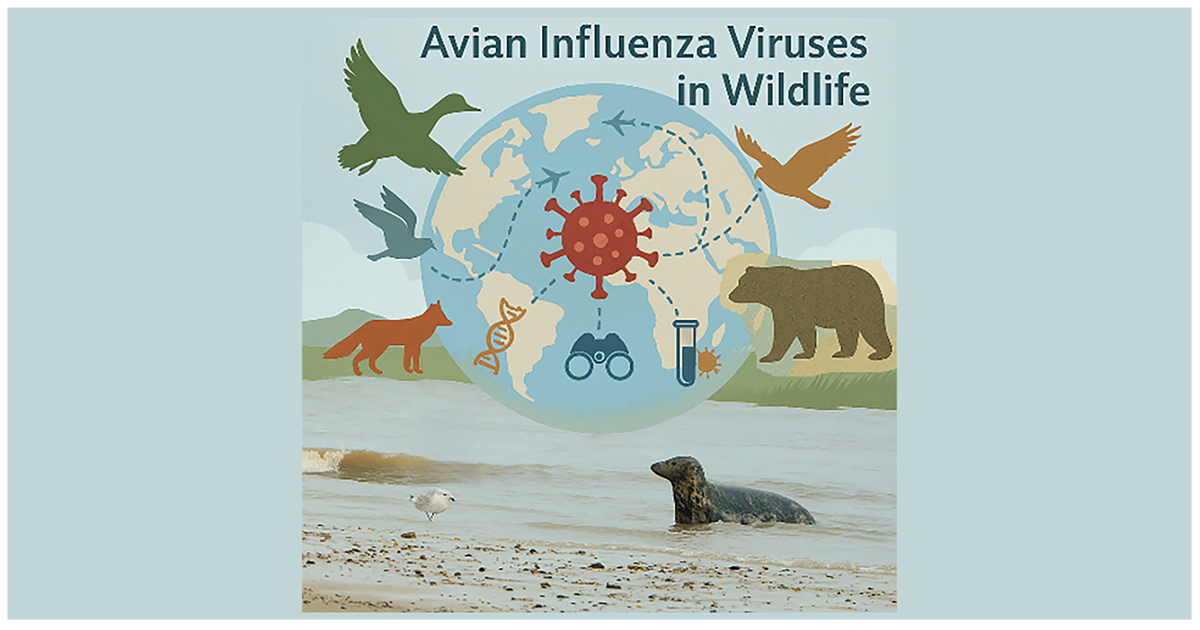Emerging and Re-Emerging Avian Influenza Viruses in Wildlife
A special issue of Pathogens (ISSN 2076-0817). This special issue belongs to the section "Viral Pathogens".
Deadline for manuscript submissions: 15 December 2025 | Viewed by 5697

Special Issue Editor
Interests: host–pathogen interactions; avian diseases; avian influenza virus; conservation research; high-throughput sequencing
Special Issues, Collections and Topics in MDPI journals
Special Issue Information
Dear Colleagues,
Avian influenza viruses (AIVs) remain a significant threat to wildlife, domestic animals, and human health. As members of the Orthomyxoviridae family, AIVs are categorized by their hemagglutinin (HA) and neuraminidase (NA) subtypes. Wild birds, particularly waterfowl, serve as the natural reservoirs of these viruses and play a vital role in their ecology—facilitating viral evolution, reassortment, and global transmission.
In recent years, outbreaks of highly pathogenic avian influenza viruses (HPAIV), notably H5N1 clade 2.3.4.4, have increasingly affected not only avian populations but also a wide range of mammalian hosts. Over 43 mammalian species across Europe, North America, South America, and Asia have been impacted by spillover events. In some cases—especially among marine mammals—these infections have been severe and fatal. Alarmingly, 2024 marked the first reported cases of efficient cow-to-cow and cow-to-human transmission of HPAIV, a pattern not previously observed in the A/goose/Guangdong (GsGD) lineage.
This Special Issue aims to highlight recent advances and emerging insights in the biology, evolution, and ecology of avian influenza viruses in wildlife. We welcome original research and review articles focused on, but not limited to, the following topics:
- Surveillance and epidemiology of AIVs in wild birds and mammals;
- Genomic and phylogenetic studies on AIV evolution;
- Impact of AIVs on wildlife populations and conservation;
- Spillover risk and interspecies transmission dynamics;
- Climate change effects on AIV distribution and migratory pathways;
- Wildlife management and control strategies;
- Novel diagnostic, modeling, and predictive tools;
- Application of high-throughput sequencing in virus detection and characterization.
We encourage submissions from the fields of virology, immunology, evolutionary biology, ecology, and public health. Studies incorporating novel methodologies and interdisciplinary approaches are especially welcome. We look forward to your valuable contributions to this important collection.
Dr. Klaudia Chrzastek
Guest Editor
Manuscript Submission Information
Manuscripts should be submitted online at www.mdpi.com by registering and logging in to this website. Once you are registered, click here to go to the submission form. Manuscripts can be submitted until the deadline. All submissions that pass pre-check are peer-reviewed. Accepted papers will be published continuously in the journal (as soon as accepted) and will be listed together on the special issue website. Research articles, review articles as well as short communications are invited. For planned papers, a title and short abstract (about 250 words) can be sent to the Editorial Office for assessment.
Submitted manuscripts should not have been published previously, nor be under consideration for publication elsewhere (except conference proceedings papers). All manuscripts are thoroughly refereed through a single-blind peer-review process. A guide for authors and other relevant information for submission of manuscripts is available on the Instructions for Authors page. Pathogens is an international peer-reviewed open access monthly journal published by MDPI.
Please visit the Instructions for Authors page before submitting a manuscript. The Article Processing Charge (APC) for publication in this open access journal is 2200 CHF (Swiss Francs). Submitted papers should be well formatted and use good English. Authors may use MDPI's English editing service prior to publication or during author revisions.
Keywords
- avian influenza virus
- HPAIV
- LPAIV
- wildlife
- surveillance
- epidemiology
- phylogenetics
- next-generation sequencing
Benefits of Publishing in a Special Issue
- Ease of navigation: Grouping papers by topic helps scholars navigate broad scope journals more efficiently.
- Greater discoverability: Special Issues support the reach and impact of scientific research. Articles in Special Issues are more discoverable and cited more frequently.
- Expansion of research network: Special Issues facilitate connections among authors, fostering scientific collaborations.
- External promotion: Articles in Special Issues are often promoted through the journal's social media, increasing their visibility.
- Reprint: MDPI Books provides the opportunity to republish successful Special Issues in book format, both online and in print.
Further information on MDPI's Special Issue policies can be found here.






